In this lesson, students explore what is beautiful with the intention of expanding their definitions of the word through the Japanese concept of wabi. A careful examination of the Natsume, Sun and Moon Thin Tea Caddy and the Ceramic Tea Caddy for Thick Tea will guide the discussion.
Students will be able to:
- describe the concept of wabi; and
- apply the concept of wabi to describe the beauty in a work of art and an object of their choosing.
Lesson
- In advance: have students bring in a favorite old shirt, a well-worn and loved stuffed animal, or some other worn but special item.
- Warm-up: Have students get into groups of 2-3. Have them choose one everyday object from their desks, pockets etc. Tell them to imagine that they are aliens from another planet who know nothing about Earth and they have to figure out what that object is used for. Remind them they have no context and can get really silly thinking up uses that relate to life on their own planet.
- Now tell the students that aliens from another planet have come to Earth and they want you to give them pictures of something beautiful to take back to their planet. Have students write on the board or butcher paper taped to the wall different things that they think are beautiful.
- Read aloud everything they have written. Pick out several examples for which you can talk about how short-lived or transient they are (e.g., a sunset, a smile) and those that are more stereotypical, perhaps from pop culture. Talk about how things that they think are beautiful are often fleeting and imperfect, and that’s part of what makes them so beautiful.
- Show the students the images of the two tea caddies. Ask them to show you thumbs up if they think the Natsume, Sun and Moon Thin Tea Caddy is beautiful and count the votes; call on some volunteers to share why they think it is beautiful.
- Ask the same question for the Ceramic Tea Caddy for Thick Tea and count those votes as well; call on some volunteers to share why.
- Compare the votes and relate their responses back to the activity from step 4. Add the following question to guide the discussion: What makes something beautiful?
- Write the word wabi on the board and talk about what it means. Share with students that wabi describes things that are simple and quiet. These things can be completely natural or man-made. Wabi sometimes refers to flaws in an object that may have happened by accident, such as the lighter spot in the glaze or the irregular hem on the bottom of the Ceramic Thick Tea Caddy (see the About the Art section for more information). These imperfections are considered unique and are deeply treasured.
- Ask students if they think the Ceramic Thick Tea Caddy is beautiful according to the concept of wabi. What makes it beautiful? How does it remind them of the principles of wabi?
- Have the students take out their well-worn objects. Ask them why they are special. Are they perfect or imperfect? How do they bring out the idea of wabi? Return to the Natsume, Sun and Moon Thin Tea Caddy. What makes it beautiful?
- Share the insights about pine trees and the role of the pine branches on the tea caddy. Ask if they can see the sun and the moon.
- Finish the lesson with students identifying three things that for them are traditionally beautiful and three that reflect the principles of wabi.
Materials
- Well-worn and loved stuffed animals, old shirts, or other similar items brought by students from home before the lesson
- Butcher paper or flip chart sheets
- One marker for every 2-3 students
- About the Art sections on Natsume, Sun and Moon Thin Tea Caddy and Ceramic Tea Caddy for Thick Tea
- One color copy of the tea caddies for every four children, or the ability to project the image onto a wall or screen
Standards
- Visual Arts
- Observe and Learn to Comprehend
- Relate and Connect to Transfer
- Language Arts
- Oral Expression and Listening
- Collaboration
- Critical Thinking & Reasoning
- Information Literacy
- Self-Direction
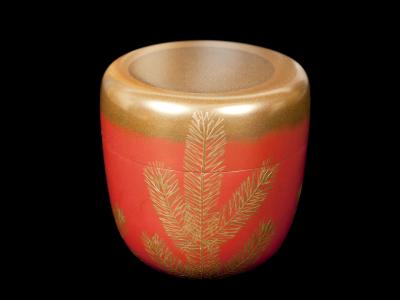
Natsume, Sun and Moon Thin Tea Caddy
Mutsumi and Misako Suzuki, Japan
1983
3 in x 2.875
Partial gift of Richard H. Kimball and Julie Seagraves and purchase in memory of Arthur A. Jolliffe, Mr. and Mrs. Mutsumi Suzuki, 1984.441
Photograph © Denver Art Museum 2011. All Rights Reserved.
This tea caddy (container) was made in Kyoto, Japan, in 1983 by Mutsumi Suzuki [mut-tsu-mee suh-ZOO-key] and his wife Misako [mee-SAH-ko]. The two work together as a team—Mutsumi does the lacquer work and Misako decorates each piece with lacquer.
Making this lacquerware piece involved many steps. Mutsumi began the process by creating a core shape out of wood. His original cores were sometimes so thin you can see through them. He then covered the wood core with a mixture of cloth, lacquer (a kind of tree sap), and a clay-like substance to create a smooth surface. Next, he applied lacquer in progressive layers. After applying each layer, he allowed the lacquer to dry, and then polished the entire piece until it had a smooth and shiny surface.
Once the lacquer work was completed, Misako decorated the object by sprinkling fine metal powder onto the surface in the shape of pine tree branches. Artists can also decorate lacquerware pieces by inserting another material into sections of the object’s surface that have been carved out, a technique called inlay. The decoration was then covered with a final layer of transparent lacquer.
It seems the Suzukis wanted to make a tea container that was perfectly crafted and decorated in a way that would make it wonderful to use during the Asian New Year. As experts in making lacquerware, they were certainly driven by their own high standards to make the caddy smooth to the touch, with designs so delicate they would please anyone who used it. When making a tea caddy, artists hope to appeal to the user’s senses of sight and touch.
Tea caddies like this one are made to hold powdered green tea, called matcha [MAH-cha], and are used in Japanese tea ceremonies. Guests at a tea ceremony learn to focus their senses on the smallest details, on everything they can see, hear, feel, and taste. Doing this can clear one’s mind of distractions like the things on a to-do list or the possibility of traffic on the way home. By relaxing and paying close attention to the sounds, smells, and emotions that accompany preparing and drinking tea, the guests can feel as though they have escaped to a calmer and more peaceful place in their minds.
The ritual of serving tea involves a number of specific steps. The ceremony can last anywhere from twenty minutes to five hours and consists of two distinct stages, represented by the drinking of thick tea (about the consistency of white Elmer’s glue) and thin tea (about the consistency and frothiness of hot chocolate). This tea caddy was made to hold thin tea and was used during the second part of the ceremony. Both types of tea are prepared by whisking green tea powder with water. Powder used to make thin tea comes from plants that are younger. Thick tea is made from the leaves of more mature tea plants. Thin tea is also made with more water.
See an example of a Ceramic Tea Caddy for Thick Tea in the Denver Art Museum’s collection.
The host chooses which tea caddy to use during the ceremony based on who is attending, the level of formality, the season, the time of day, and how the caddy will complement other utensils like the tea bowl. Thin tea containers are often decorated with seasonal designs. The pine tree and the color red make this tea caddy appropriate for winter, especially for the Asian New Year.
When preparing for the ceremony, the host places a little mound of powdered green tea inside the container. Once the ceremony begins, he removes the lid of the caddy and scoops a small amount of tea powder into a tea bowl, whisking it with hot water to create a bitter green tea. Thin tea is then served to the guests in individual bowls. After the guests have finished their tea and the host has cleaned the utensils, the guests will often examine each item, noticing its color, shape, size, glaze, and texture. The utensils are handled with extreme care and reverence because they are often very valuable.
Information about the Japanese tea ceremony can be found here.
Two examples of tea bowls in the Denver Art Museum’s collection:
Details

Pine Branches
Golden pines grow up the sides of the caddy. In Japanese and Chinese culture, the pine is a symbol of longevity, good fortune, and steadfastness because of its ability to withstand strong winds, rain, and snow, and because it stays green throughout the year. Pines can also survive in rocky areas and may live for several centuries. The pine is considered virtuous and is a symbol of winter and the New Year. Note how the pine branch crosses over from the lower body of the caddy to the lid. In Japan, this kind of continuous design from one part or side to another is often used to delight the eye.
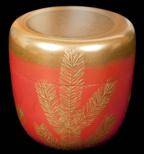
Shape
The container narrows a little at the base and has a slightly convex top. Containers like this one are similar in shape to the jujube fruit and are called natsume [nah-tsu-me], which is the Japanese word for jujube fruit. More facts about the jujube fruit can be found here.
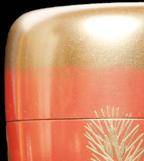
Shiny Surface
The container’s shiny surface is the result of many layers of polished lacquer, a material that is made from the sap of lacquer trees. The lacquer tree is a close relative of poison oak and poison ivy. Artists must gradually build up immunity to the sap so that it does not irritate their skin.
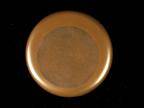
Circle
The circle on top of the container could represent the Sun and/or the Moon. The artists left this ambiguous.

Asymmetry
The circle on the top is off-center, an intentional design choice made by Matsumi. She may have chosen to place the circle closer to one edge of the lid in order to catch the attention of those who use the caddy. She might also have chosen to place the circle closer to the front end of the piece to emphasize the natural asymmetry of the container.
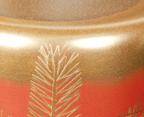
Golden Halo
The golden halo surrounding the circle seems to represent the glowing light emitted by the Sun or Moon. The technique used to create this very gradual change in color—from red to gold—requires a great deal of skill.

Red Sides
The golden halo fades into a brilliant red halfway down the lid. This could represent the distinction between sky (lid) and earth (sides). In Japanese art, it is common to see a continuous design that moves from one part of an object to another.

Signature
There is a signature scratched into the bottom of the caddy.
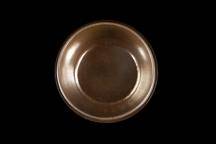
Inside
The interior of the container is black and silver, and is flecked with gold. The base of the interior is more square than the exterior.
Funding for object education resources provided by a grant from the Morgridge Family Foundation. Additional funding provided by the William Randolph Hearst Endowment for Education Programs, and Xcel Energy Foundation. We thank our colleagues at the University of Denver Morgridge College of Education.
The images on this page are intended for classroom use only and may not be reproduced for other reasons without the permission of the Denver Art Museum. This object may not currently be on display at the museum.







